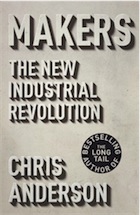Makers: The New Industrial Revolution
by Chris Anderson

Chris Anderson thinks you might be a toy company. After telling the heart-warming anecdote of how he fabricated some doll's house furniture for his daughters using a new 3D printer – which works like an inkjet printer but sprays down layers of liquefied plastic to make a solid object – the former Wired editor says he might never buy doll's house furniture again. "If you're a toy company," Anderson threatens, "this story should give you chills." I didn't get chills, but then I'm not a toy company.
This is the sort of book, however, that is mainly aimed at corporate persons, and at individuals only to the extent that they work for corporate persons, cherishing the dream of becoming an "entrepreneur", that perfection of the human spirit to which all human history, at least as Anderson recounts it, has been leading.
The book is a compendium of narrative chunks headed with PowerPoint-friendly slogans ("Remixing the physical world") and studded with inspirational examples, often introduced with the paradigmatic pop-business pseudo-conjunction "Take". ("Take Sparkfun …", "Take, for instance, Open Source Ecology …") As standalone vignettes, many of them are fascinating. Anderson has authentic geek cred, and displays an infectious enthusiasm and a vivid journalistic rhythm when he is narrating a morning's tinkering with an autonomous toy helicopter, visiting Tesla's electric-car factoryand describing SpaceX's rocket-production facilities, or explaining the capabilities of the 3D printers (Some dentists already use them to make custom-fitted crowns while you wait). Anderson recalls persuasively how impressive the apparition of "desktop publishing" was in the 1980s – publishing! right from your desktop! – and looks forward to widespread "desktop manufacturing".
It's notable, though, that there are no dark clouds in Anderson's futurist sky. From recent news it seems that 3D printing is going to be especially appealing to, among others, survivalist gun nuts: this summer, one man successfully printed the lower receiver of an assault rifle (the part that usually bears the serial number), and completed the weapon with off-the-shelf parts that don't require a licence to purchase. At the end of his book, meanwhile, Anderson briefly considers the sunny possibilities of future desktop biotech engineering (or "DIYBio"), betraying no concern that, when such lifehacking facilities are so widely distributed, anyone would think of creating an organism more alarming than, say, a bright-green dwarf bunny. For Anderson, there is no Long Tail of amateur bioterrorism. (His successful 2006 book The Long Tail, about new "niche" markets enabled by the internet, has been criticised by economists, but he obviously feels that the phrase is too good not to repurpose: in this book we hear of "the Long Tail of things", "the Long Tail of stuff", "the Long Tail of talent", and even "the Long Tail of Lego". This is the Long Tail of brand-enhancing reuses of "the Long Tail".)
Anderson is eminently capable of hip, fine-grained tech analysis (his description of Lego blocks as "programmable matter" is ingenious); more problematic are the wider argument-predictions he makes – helping himself on the way to highly dubious interpretations of Hayek and Jefferson – in order, presumably, to enable the book to address toy companies. At this business-class cruising altitude, his techno-economic utopia looks curiously scrambled. The "new industrial revolution" of the book's subtitle will allegedly see lessons from the internet – the world of "bits" – applying to the world of "atoms" too. The creation of physical commercial products will now benefit from the power of "network effects" and other dog-whistle buzzwords for the chin-stroking cybertheory community. Hot tech startups can get their manufacturing done cheaply using 3D printers and robots: in this way, what Anderson grandly calls "the Maker movement" will create lots of new jobs, reversing America's industrial decline. (The book thus also positions itself in the burgeoning genre of American books asking How Can We Beat China?)
At the same time as it creates lots of new jobs, however, the Maker movement – at least as Anderson describes its recipe for success – will also be destroying lots of jobs: by replacing humans with robots in manufacturing, or by uploading product blueprints to be made in factories in other countries. Parts of the book, indeed, read like a 1990s manual on the virtues of outsourcing. ("I've ordered custom electric motors for a robotic blimp from a specialty motor-maker in Dongguan," Anderson writes, in perhaps the book's most amazing sentence.)
It's also striking that the early Maker companies that Anderson celebrates are all making nothing but shiny gewgaws for the rich: "cool stickers for Macbooks", toy helicopters, noise-cancelling wireless headsets, computerised wristwatches, or a $75,000 dune-buggy kit. Indeed, he acknowledges that mainstream commodity products will continue to be mass-produced in the old way (except with more robots), taking advantage of economies of scale. Instead, the Maker entrepreneur should aim upmarket. "Just think of couture fashion or fine wines," Anderson advises with avuncular worldliness. After all, the "local furniture maker can compete with IKEA only by serving the rich". There is indeed very little patience, in this book's Silicon Valley ideology of ambient über-wealth, for the ordinary and humdrum. Anderson has his own pet examples of the loser kind of company that can't exhibit the rapid growth of a Maker startup: local pizza franchises and dry cleaners, to which he dismissively refers on three separate occasions. They're just not "innovative" enough.
Few techno-utopias are as confusing as this one. In Anderson's brave new world, everyone is a creative-geek tinkerer but no one does the boring stuff. There will be lots more jobs created in manufacturing – even though the entrepreneurs are persuading people to work for free and also employing as many robots as possible. (I for one welcome our new robot underlords, as long as they don't come to resentful consciousness of their slave-state and overthrow us, as they do in Karel Capek's R.U.R.and most dystopian robot fiction since.) And at the end of a long day's Making of exclusive knick-knacks for the anomic plutocracy, where will these hero-entrepreneurs go to scarf a pepperoni slice or get their custom-printed shirts laundered? Who cares, right? There will probably be robots for that too before long.

No comments:
Post a Comment